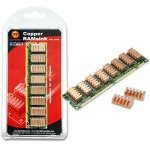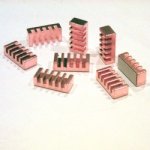There is a quick tweak that you guys can try.
Thermaltake sells copper ram heatsinks for DRAMs. These heatsinks comes with a special 3M heat conductive adhesive to allow one to stick it securely to the any chip.
These heatsinks are rather thick and they should also act as good shields for EMI/RF shielding purposes.
The heatsinks are retailing at a couple of buck for a pack of 8.
You can stick them to your dac, receivers, opamps, digital filters etc...
Thermaltake sells copper ram heatsinks for DRAMs. These heatsinks comes with a special 3M heat conductive adhesive to allow one to stick it securely to the any chip.
These heatsinks are rather thick and they should also act as good shields for EMI/RF shielding purposes.
The heatsinks are retailing at a couple of buck for a pack of 8.
You can stick them to your dac, receivers, opamps, digital filters etc...
Attachments
Hi Ruach,
Sounds like a good idea. I'm sick of messing around with self adhesive copper tape!!
I'm wondering now whether or not there is any benefit or disadvantage to cooling chips in a DAC or similar?
Is it preferable to keep them as cool as possible or keep them at a slightly higher temperature (without these heatsinks)?
Also in the UK these cost around 8 pounds
(The similar blue anodised aluminium version is cheaper and lighter but obviously diificult to solder.)
I'm definitely interested for the RFI alone but the thermal properties got me thinking.
Any ideas?
Sounds like a good idea. I'm sick of messing around with self adhesive copper tape!!

I'm wondering now whether or not there is any benefit or disadvantage to cooling chips in a DAC or similar?
Is it preferable to keep them as cool as possible or keep them at a slightly higher temperature (without these heatsinks)?
Also in the UK these cost around 8 pounds

(The similar blue anodised aluminium version is cheaper and lighter but obviously diificult to solder.)
I'm definitely interested for the RFI alone but the thermal properties got me thinking.

Any ideas?

Ruach said:
These heatsinks are rather thick and they should also act as good shields for EMI/RF shielding purposes.
You'd need to connect these heat sinks to ground to get the EMI/RF shielding. Wires to connect them to ground should be as short as you can easily make them, like a few centimeters long. But be careful you don't create any ground looks if you use multiple wire connections.
Yep. To get proper shielding, you have to connect the heatsink to the ground via a short length of wire.
I did an experiment without the ground connection and I found out that as long as the copper sheet is thick, there will be some form of shielding.
In Singapore, a set of 8 copper heatsinks goes for 6 euros. But due to a lack of demand, the distributor has decided not to bring them in anymore.
I am trying to do a small group buy to bring some of these fellows in.
I did an experiment without the ground connection and I found out that as long as the copper sheet is thick, there will be some form of shielding.
In Singapore, a set of 8 copper heatsinks goes for 6 euros. But due to a lack of demand, the distributor has decided not to bring them in anymore.
I am trying to do a small group buy to bring some of these fellows in.
I'm very surprised to hear that.Ruach said:
I did an experiment without the ground connection and I found out that as long as the copper sheet is thick, there will be some form of shielding.
I've used copper foil for shielding in the past but soldering to it ( before application of course) often degrades the adhesive and makes a good reliable fix quite difficult.
Any opinions on the issue of temperature?
how about connecting the heatsinks in 'series' with wires, and then to ground? wouldn't that avoid any issues with ground loops?
anyway, for what it's worth, this sounds like a good idea. heat is the enemy of electronics; the less, the better for both lifespan and value drift. the emi/rfi protection is just icing on the cake imo.
anyway, for what it's worth, this sounds like a good idea. heat is the enemy of electronics; the less, the better for both lifespan and value drift. the emi/rfi protection is just icing on the cake imo.
Sonusthree said:
I've used copper foil for shielding in the past but soldering to it ( before application of course) often degrades the adhesive and makes a good reliable fix quite difficult.
Any opinions on the issue of temperature?
The glue used with heatsinks is based on a epoxy base.
And it can be aplied after soldering.
i also think the epoxy can handle the soldering temparatures.
removing the epoxy glued heatsinks can be done by freezing the the components. When frozen use some force.
(worked fine on my graphicscard)
seoman said:removing the epoxy glued heatsinks can be done by freezing the the components. When frozen use some force.
(worked fine on my graphicscard)
plus use a twisting motion (like opening a jam jar's screw-top lid) rather than a pulling motion (like opening a soft drink can's tab) when removing the heatsink to prevent tearing components off pcbs.
I've used copper foil for shielding in the past but soldering to it ( before application of course) often degrades the adhesive and makes a good reliable fix quite difficult.
The purpose of shielding is to shunt RFI to ground. How can you achieve this whithout connecting the copper heatsinks close to the gnd pin of the underlying IC? So soldering is inevitable! Ho cares about adhesive ..buy a new epoxy kit!!
no ..no ..no!! Each shield must be connected close to the underlying IC. Otherwise you generate a RF mess radiating everywhere!how about connecting the heatsinks in 'series' with wires, and then to ground? wouldn't that avoid any issues with ground loops?
Ground loops aren't generated by single shields connected each indipendently at one single gnd point.
mrjam said:Ground loops aren't generated by single shields connected each indipendently at one single gnd point.
ah... star grounding. i get it.
What about resonance? Would these heatsinks not work as nice tuning forks stuck to the top of the dac chip inducing mechanical vibes?
Heard somewhere that the internal sink on the TDA1541 can be excited to resonate hence Naim took some trouble to specifically isolate the 1541 from vibration on the original CDS...
Just hearsay.....
Heard somewhere that the internal sink on the TDA1541 can be excited to resonate hence Naim took some trouble to specifically isolate the 1541 from vibration on the original CDS...
Just hearsay.....
adhoc said:
ah... star grounding. i get it.
No, just individual grounds in close proximity to the chip.
Andy
Looks like a good idea Ruach, esp. for the old Philips chipset (SAA7220 / TDA1541) which run hot - I must find some and try this 

Yes they did - in fact all their CD players (except the CD3, 3.5, 5 and 5i/ 5x) have sprung suspension for the PCBs!Heard somewhere that the internal sink on the TDA1541 can be excited to resonate hence Naim took some trouble to specifically isolate the 1541 from vibration on the original CDS...
Hey guys,
Do try it out and see if this tweak works for you. It is cheap and it is very easy to implement.
You can either ground it or if you are lazy like me, stick it on the chips and do the grounding another time.
The copper heatsinks are about 2.5 to 3mm thick and they are quite heavy (relatively to the aluminium heatsinks).
The fins are too short to act as a tuning fork and even if this is the case, I am sure that you guys can find a way to damp it.
In my crude experiments based on a handphone as the generator of EMI/RF, I found that thicker copper sheets provide better protection from EMI/RF.
FYI, the Arcam Black Box 1 and 2 have sprung suspension for their TDA1541A chips too.
Do try it out and see if this tweak works for you. It is cheap and it is very easy to implement.
You can either ground it or if you are lazy like me, stick it on the chips and do the grounding another time.
The copper heatsinks are about 2.5 to 3mm thick and they are quite heavy (relatively to the aluminium heatsinks).
The fins are too short to act as a tuning fork and even if this is the case, I am sure that you guys can find a way to damp it.
In my crude experiments based on a handphone as the generator of EMI/RF, I found that thicker copper sheets provide better protection from EMI/RF.
FYI, the Arcam Black Box 1 and 2 have sprung suspension for their TDA1541A chips too.
Well,
My Thermaltake copper heatsinks arrived today but they are diferent to the ones pictured above. The ones that I have bought have a square base and unfortunately are pretty incompatible with the I.C.'s in my CD player. Especially as they are SMD devices.
I have attached 2 of these across four regulators that lay flat on the PCB. So that 2 regs share 1 heatsink. I know it's probably a waste of time and money but what else can I do with them?!!
They are pretty cool things in the flesh though and are surprisingly heavy and rugged for their size. The adhesive sticks fairly well but leaves the sinks able to be twisted slightly.
I'm pretty sure they're going nowhere though unless I drop my player!!
If anyone wants to get some of these then just make sure they are the right version.
Cheers,
S3.
My Thermaltake copper heatsinks arrived today but they are diferent to the ones pictured above. The ones that I have bought have a square base and unfortunately are pretty incompatible with the I.C.'s in my CD player. Especially as they are SMD devices.
I have attached 2 of these across four regulators that lay flat on the PCB. So that 2 regs share 1 heatsink. I know it's probably a waste of time and money but what else can I do with them?!!
They are pretty cool things in the flesh though and are surprisingly heavy and rugged for their size. The adhesive sticks fairly well but leaves the sinks able to be twisted slightly.
I'm pretty sure they're going nowhere though unless I drop my player!!
If anyone wants to get some of these then just make sure they are the right version.
Cheers,
S3.
- Status
- This old topic is closed. If you want to reopen this topic, contact a moderator using the "Report Post" button.
- Home
- Source & Line
- Digital Source
- Copper heatsink tweak - Thermaltake Copper Heatsinks

